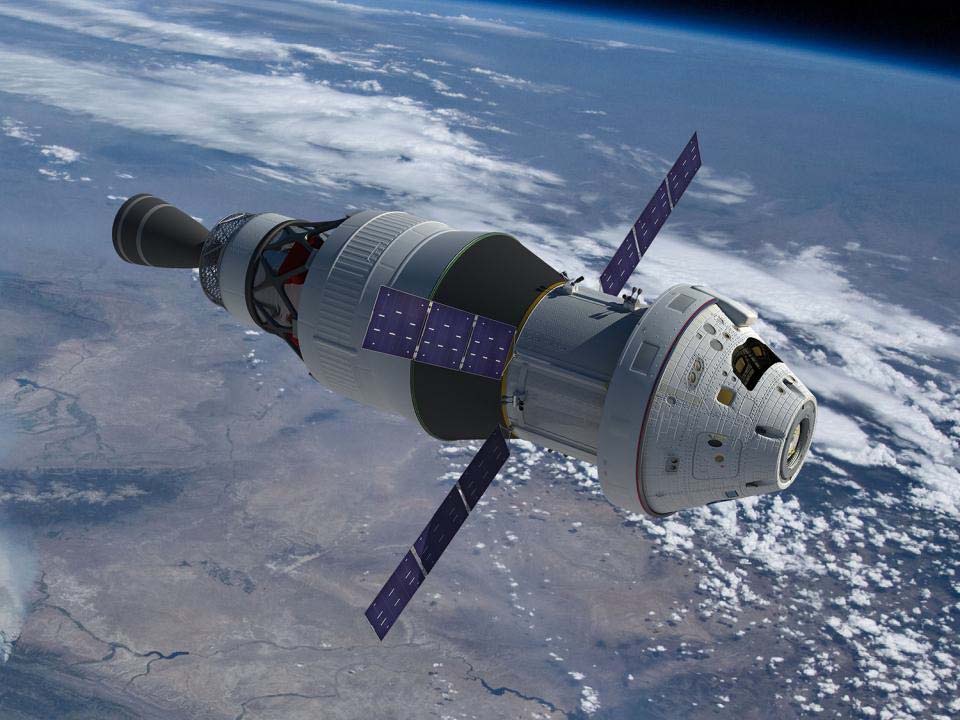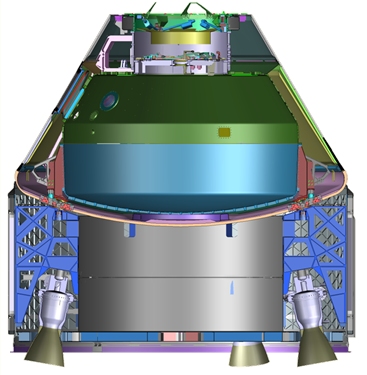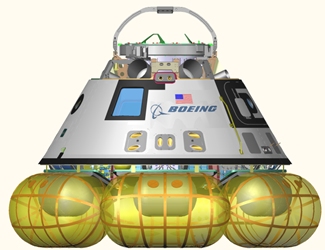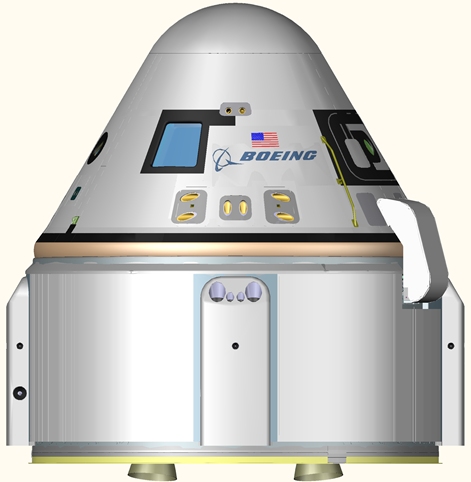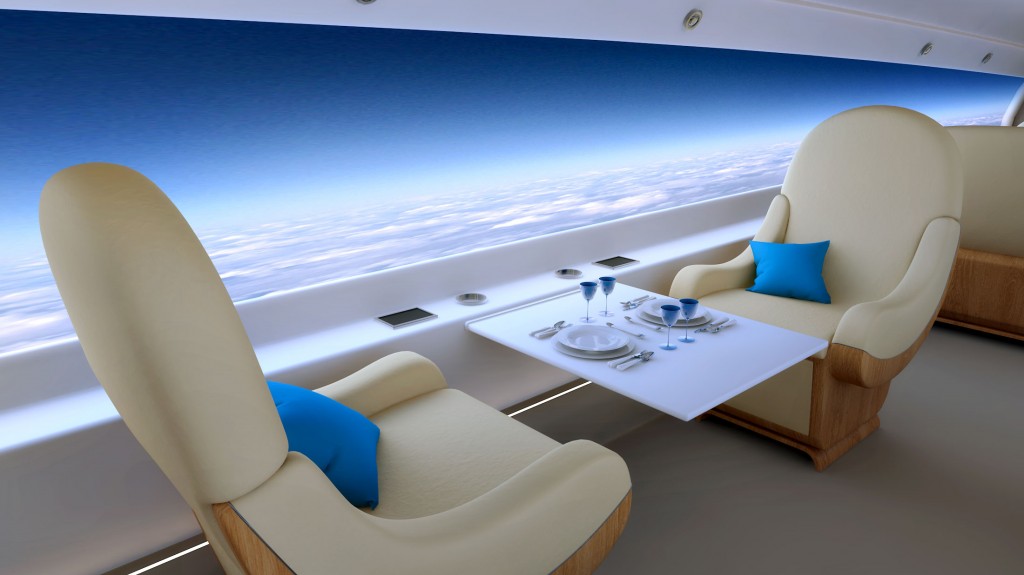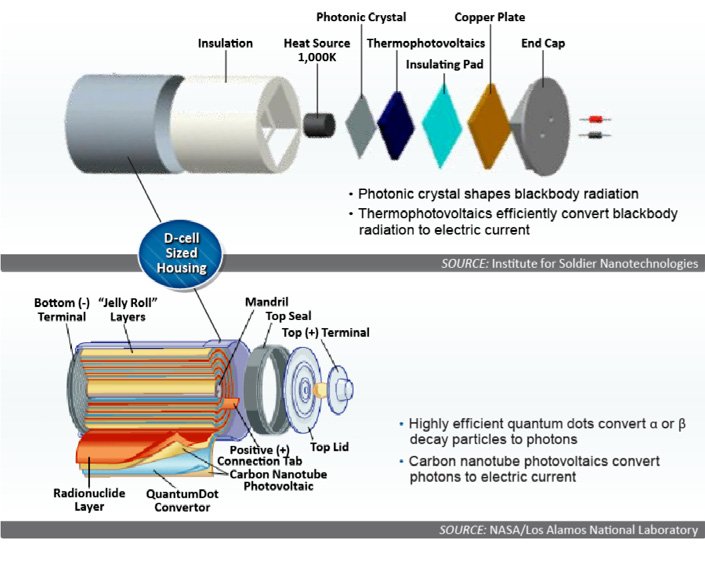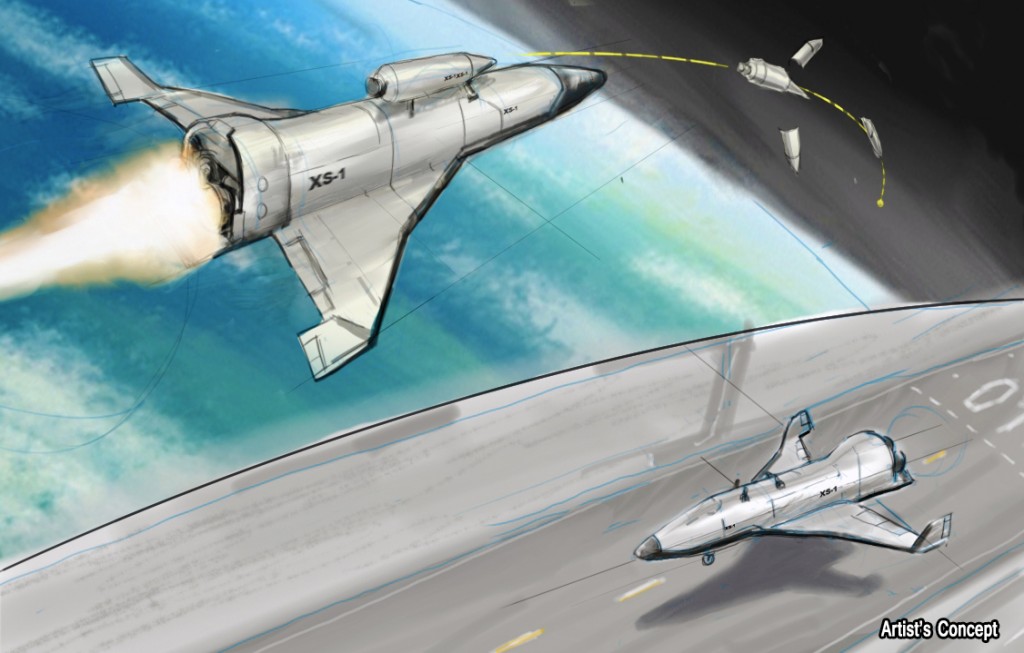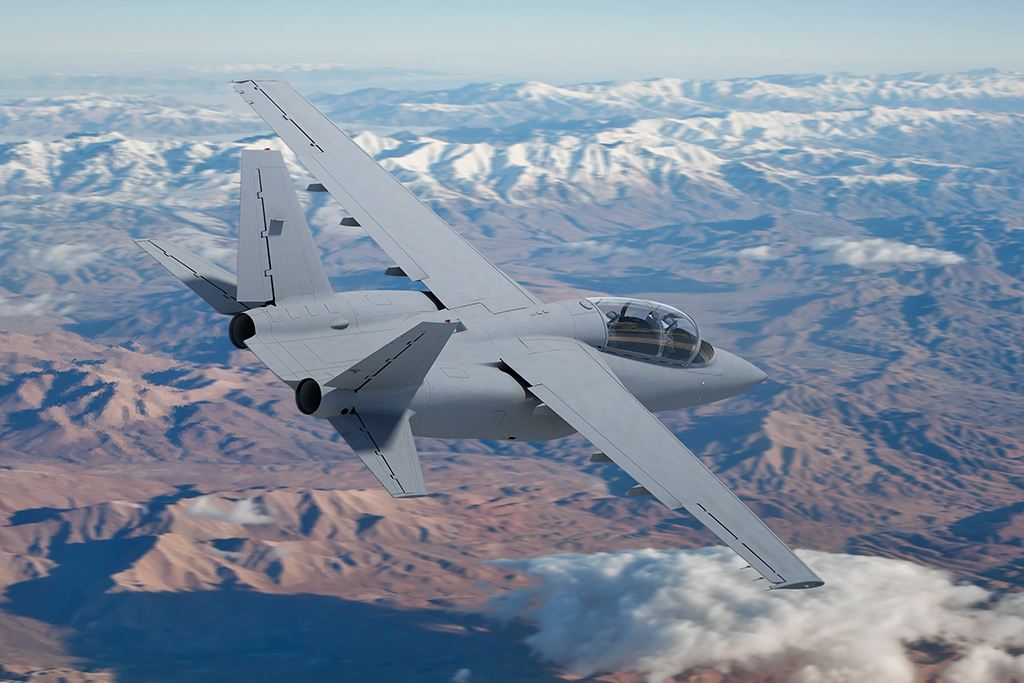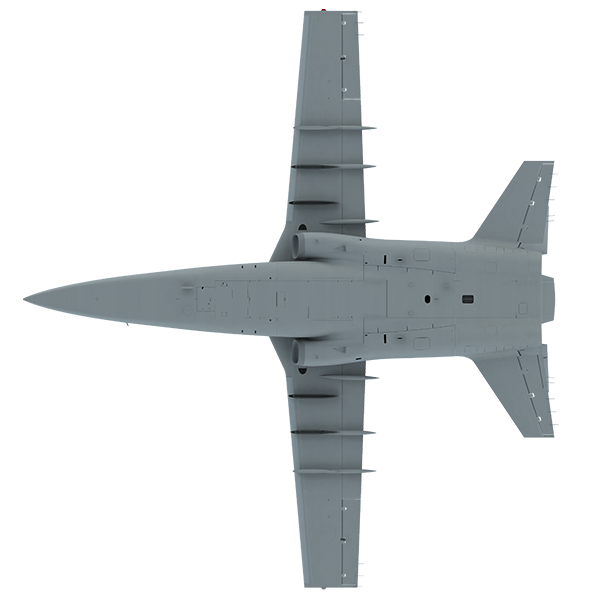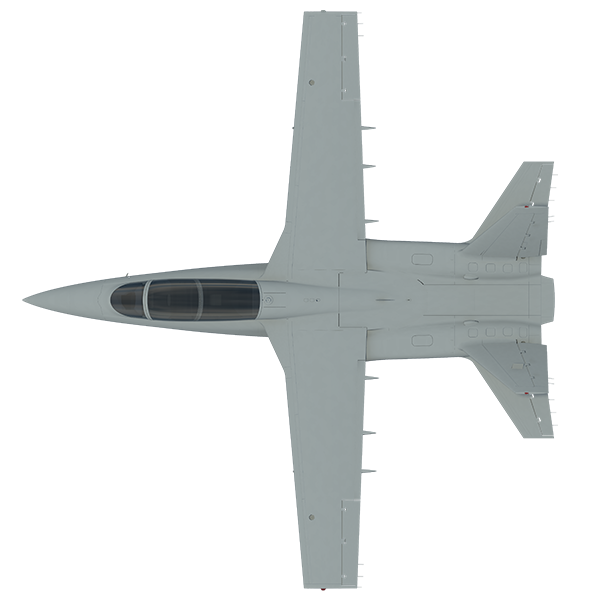Recent NASA artwork depicting the Orion space capsule and ESA service module atop a Delta IV derived upper stage.
Spike Aerospace, about which I know approximately nothing, wants to build a Mach 1.6 SSBJ known as the S-512. For a SSBJ, it’s a fairly conventional design. However, what’s getting it some press is the idea that it won’t have any passenger compartment windows; instead, it will have a long window-like high-def display strip which will show an external view.
While it looks spiffy in the PR art… unless this display is some sort of sci-fi holographic display, it will looks distinctly “off” compared to a real window. If you are up front, for example, and you look out the “window” well aft, rather than showing you a view looking aft, it will show you a view looking off to the side.
Someday I imagine materials tech will be such that an actual window strip can be made for pressurized aircraft. And that… will be odd.
If the computer generated artwork on their site is anything to go by (and it may not be), the design does not seem to be very far advanced. The landing gear, for example… yeesh. Span is 60 feet, length 131 feet; 12 to 18 passengers; cruises at Mach 1.6, dash at Mach 1.8; MTOW = 84,000 lbs; engines, 2 P&W JT8D; range 4000 nautical miles. There are a few sonic boom-fighting elements… long nose, engines hidden above the fuselage, reduced number of surfaces. But it remains to be seen if the FAA would allow supersonic overflight of land areas in the US.
Until December 18, the AIAA is selling 25 books for $25, and ten books for $10. Some good stuff here at some pretty substantial discount. You don’t have to be an AIAA member to get the discount.
NOTE: I have no relationship with the AIAA, and don’t make a nickel off these sales. So.. if you want to buy stuff and still feel like you are Supporting The Cause, feel free to navigate to Amazon.com through the “Search’ box that’s to the upper right of this page. i get a tiny fraction of the sales prices for items purchased via search & referral. I suggest buying stuff like laptops and computers and cars and such. So long as I’m getting a small percentage, it might as well be a small percentage of a large dollar value…
The Aircraft Designers: A Grumman Historical Perspective
Michael V. Ciminera
$39.95
NOW $25!
Meeting the Challenge: The Hexagon KH-9 Reconnaissance Satellite
Phil Pressel
$39.95
NOW $25!
Space Shuttle Legacy: How We Did It and What We Learned
Roger D. Launius; John Krige; James I. Craig
$49.95
NOW $25!
Augustine’s Laws
Norman R. Augustine
$39.95
NOW $25!
100 years of Flight
Frank H. Winter and F. Robert van der Linden
$69.95
NOW $25!
Have Blue and the F-117A: Evolution of the “Stealth Fighter”
David C. Aronstein and Albert C. Piccirillo
$59.95
NOW $25!
Advanced Tactical Fighter to F-22 Raptor: Origins of the 21st Century Air Dominance Fighter
David C. Aronstein, Michael J. Hirschberg, and Albert C. Piccirillo
$49.95
NOW $25!
Aerodynamic Principles of Flight Vehicles
Argyris Panaras
$49.95
NOW $25!
Voyager Tales: Personal Views of the Grand Tour
David W. Swift
$74.95
NOW $25!
Hans Von Ohain
Margaret Conner
$54.95
NOW $25!
Road to Mach 10: Lessons Learned from the X-43A Flight Research Program
Curtis Peebles
$39.95
NOW $25!
Eleven Seconds into the Unknown
Curtis Peebles
$39.95
NOW $25!
Blazing the Trail: The Early History of Spacecraft and Rocketry
Mike Gruntman
$39.95
NOW $25!
The Rocket Company
Patrick Stiennon and David Hoerr
$34.95
NOW $25!
Rocketdyne: Powering Humans into Space
Vince Wheelcock
$39.95
NOW $25!
Space Exploration and Astronaut Safety
Joseph N. Pelton
$49.95
NOW $25!
Shades of Gray
L. Parker Temple III
$49.95
NOW $25!
Unmanned Aviation: A Brief History of Unmanned Aerial Vehicles
Laurence R. Newcome
$44.95
NOW $25!
Starting Something Big: The Commercial Emergence of GE Aircraft Engines
Robert V. Garvin
$39.95
NOW $25!
The Power to Fly: An Engineer’s Life
Martin Ducheny and Brian Rowe
$39.95
NOW $25!
Aerospace Engineering Education During the First Century of Flight
Barnes McCormick; Eric Jumper; Conrad Newberry
$89.95
NOW $25!
The History of North American Small Gas Turbine Aircraft Engines
Richard Leyes II; William Fleming
$49.95
NOW $25!
Methods to Extend Mechanical Component Life: Lessons Learned with Space Vehicle and Rocket Engine Components
Dieter Huzel
$44.95
NOW $25!
The Engines of Pratt & Whitney: A Technical History
Jack Connors
$49.95
NOW $25!
From Rainbow to Gusto
Paul A. Suhler
$39.95
NOW $25!
Experiments in Aerodynamics
S. Langley
$29.95
NOW $10!
Skycrane: Igor Sikorsky’s Last Vision
John A. McKenna
$39.95
NOW $10!
Hired Minds
Bryan Gardner
$19.95
NOW $10!
Terminal Chaos: Why U.S. Air Travel Is Broken and How to Fix It
George L. Donohue; Russell D. Shaver II
$29.95
NOW $10!
Space: The Fragile Frontier
Mark Williamson
$39.95
NOW $10!
Rocketeers and Gentlemen Engineers
Tom Crouch; Buzz Aldrin
$39.95
NOW $10!
The Superpower Odyssey: A Russian Perspective on Space Cooperation
Yuri Karash
$49.95
NOW $10!
Centennial of Powered Flight
Gerard Faeth
$24.95
NOW $10!
When the Airlines Went to War
Robert Serling
$24.95
NOW $10!
Advice to Rocket Scientists
Jim Longuski
$19.95
NOW $10!
Take this for what it’s worth:
PLA dreams of turning moon into Death Star, says expert
An expert from the China National Space Administration’s Lunar Exploration Programme Center… added that the moon is the Earth’s only natural satellite, and it can be transformed into a deadly weapon. Like the Death Star in Star Wars, the moon could hypothetically be used as a military battle station and ballistic missiles could be launched against any military target on Earth.
Various weapons testing sites could also be established on the moon, the source said.
Welcome to Project Horizon V 2.0.
For those unaware, Project Horizon was a 1959 US Army study of a moon base for military purposes. Included in that was the use of the moon as a missile base. The idea is not *entirely* ludicrous: a missile base on the moon would be several days away from a strike launched from Earth. So if Nation A launched a first strike on Nation B and Nation B has a lunar base, then Nation A can expect a rain of ruin from the moon a little later. However, the US decided that Polaris missile subs were cheaper.
Seemed to go reasonably well. Some reports later that my audio faded in and out… I can only assume that my phone was either on the fritz, or perhaps the phone line itself was a bit screwy. Anyway, you can download it in MP3 format here:
http://archived.thespaceshow.com/shows/2134-BWB-2013-12-02.mp3
If you have a question raised specifically by the interview, you can ask it either here, or at the Space Show blog:
http://thespaceshow.wordpress.com/2013/12/03/scott-lowther-monday-12-2-13/
One minor correction: I was asked what the first US bomber was. I seemed to recall that the US dropped bombs from biplanes during the Pancho Villa expeditions of 1916; I was close, as there were Curtis biplanes modified to drop small incendiaries sent to Mexico, but the bombs were not dropped.
The complete rework of APR from the original release a decade ago is going a lot slower than I’d planned. A lot of people have asked for the original versions of the as-yet-unreleased issues of APR to be made available. I’ve been hesitant to do so, but… it’s just taking too long. So, I’ve taken the original Word files for the six issues of Volume 4 and the six issues of Volume 5, and made two PDF files from them. I’m making them temporarily available as two bulk sets. When the issues are re-released, these full-volume sets will be withdrawn. So, Volume 5 might remain available till the sun explodes, I dunno…
If you’re dying to get hold of the old-school APRs, here’s your chance. Remember, these are the *original* files from around 2002-2004, without any updates, edits or other changes. Errors, crappy formatting and all. A bunch of the individual old articles remain available as well.
APR Original Run Volume 4 downloadable PDF: $30
———
APR Original Run Volume 5 downloadable PDF: $30
———
Here are the contents:
Volume 4:
The X-15 Research Airplane Competition: The Bell Aircraft Proposal by Dennis R. Jenkins
First in a series of articles describing the competitors for the X-15
Lockheed Model L-153 Part 2 by Bill Slayton
Immediately post-war M-wing jet fighter designs
Cobras Of The Field by Scott Lowther
Modified helicopters for ag duty
Lockheed Model L-153 Part 3 by Bill Slayton
Immediately post-war swept-wing jet fighter designs
The X-15 Research Airplane Competition: The Douglas Aircraft Proposal by Dennis R. Jenkins
The Douglas competitor for the X-15
The Martin “Spacemaster” by Scott Lowther
An unconventional design competitor for the Shuttle
Radial Engine P-51 Mustang by Scott Lowther
A little-known modification to the supreme WWII fighter
The X-15 Research Airplane Competition: The Republic Aviation Proposal by Dennis R. Jenkins
The Republic competitor for the X-15
Boeing Super Clippers, then and Now by Scott Lowther
Truly grand aircraft
The X-15 Research Airplane Competition: The North American Proposal by Dennis R. Jenkins
The winning competitor for the X-15
The HFB 530 Ranger by Mike Hirschberg A German VTOL strike/recon design
Lockheed Model L-153 Part 4 by Bill Slayton
Early Post-war variable geometry fighters
Sonic Cruiser Update by Scott Lowther
New drawings of a new aircraft
LARA Craft: COIN Raiders by Scott Lowther
A long way to go for a bad pun for some tough aircraft
English MUSTARD by Scott Lowther
An early 1960’s British fully reusable Space Shuttle
The NACA’s First Jet by Scott Lowther
The last gasp for ducted fans prior to the turbojet
Addendum to Issue V4N5
Ooops.
The Hopeless Diamond by Scott Lowther
The first cut of the stealth fighter
Sea Dragon by Scott Lowther
A giant, dirt-cheap launch vehicle
North American NA-116 by Scott Lowther
A long-range bomber
Multibody Designs From Lockheed by Scott Lowther
Unconventional yet fuel efficient designs
————————–
Volume 5:
Editor’s Gratuitous Additions: Republic XF-103
A little bit of extra info.
Republic XF-103 by Dennis R. Jenkins
About as sleek as an aircraft can get.
Boeing’s Advanced Multipurpose Large Launch Vehicle by Scott Lowther
Perhaps the most powerful space launcher ever seriously conceived.
McDonnell Douglas GRM-29A by Scott Lowther
Just about the coolest spaceplane ever… but would it have worked???
The Rockwell XFV-12A V/STOL Prototype by Dana E. Lubich
It came close…
XFV-12A Followons by Scott Lowther
The end of the program wasn’t the end of the concept
Hawker Siddeley HS 141 by Scott Lowther
VTOL jetliner concept
Bell/Boeing Armed XV-15 by Scott Lowther
A tilt rotor with a mission
Lockheed Sea Sitter by Scott Lowther
A seaplane to conquer the oceans
Early Atlas Missile Designs by Scott Lowther
Evolution of America’s first ICBM
Boeing’s Air-Launched Micro-Fighters by Scott Lowther
The fighter needed for a flying aircraft carrier
Chrysler SERV by Scott Lowther
An SSTO Space Shuttle design
Soviet Seaplane Jet Bombers by Thomas Mueller and Jens Baganz
A counterpoint to American efforts
4,000 Ton Orion by Scott Lowther
Recently declassified data on a large nuclear pulse propulsion craft
Mart Model 262 by Scott Lowther
A mysteriously delayed article on VTOL fighters…
NASA Langley High Speed Civil Transport by Scott Lowther
Mach 3 and Mach 4 transports from the late 1980’s
Convair/Canadair Tilt-Wing Close Support Aircraft by Scott Lowther
VTOL gunship
Spacejet by Scott Lowther
Spaceplanes with dropable jet engines
Handley Page All-Wing Airbus by Scott Lowther
A British flying-wing transport from the 1960’s
Convair NX-2 Nuclear Powered Bomber by Scott Lowther
A well known but – until now – poorly documented nuclear powered aircraft project
Technology Needs for High Speed Rotorcraft Part 1 Sikorsky and Bell by Scott Lowther
Tiltrotos, tiltwings, fan-in-body designs
Lockheed-Martin ICE by Scott Lowther
An experimental tailless stealth fighter design
Raumwaffe, 1946
Boeing WS-110A
X-Wings
Dash-On-Warning
Two notional concept for “nuclear batteries were shown in a Defense Science Board report:
The upper concept shows something of a conventional radioistotope thermionic generator, but in small scale. Within it is a 1-cubic centimeter chunk of material infused with alpha and/or beta emitter; the radiation is emitted and absorbed within the chunk, raising the temperature to 1000 Kelvin. A “photonic crystal” captures the blackbody radiation (which in this case would be well into the visible at that temperature) and deposits it onto a thermophotovoltaic cell, where it is converted to electricity. The insulating shell keeps the exterior temperature to about 25 degrees C.
The lower design uses a “jelly roll” configuration with thin flat sheets of alpha and/or beta emitter sandwiched between a sheet of quantum dots, which directly converts the radiation to electricity.
Both designs seem to be made for the same requirements, would produce one to five watts for several years. The radioactive material would be americium or plutonium-238. Pu-238 is a strong alpha emitter, and produced about 0.39 of a watt per gram, so several dozen grams might be needed, depending on efficiency. The only real use for Pu-238 is radioisotope thermionic generators, used on spacecraft; these nuclear batteries would be quite similar. The sad thing is that the US stopped producing Pu-238 in 1988; we now buy it from Russia… but even they have stopped producing it. NASA and the DoE are trying to restore production at a rate of 1.5 kilos or so per year. Since these “nuclear D-cells” are specifically for military applications, restoring manufacturing capability would seem to be needed as a single D-cell would consume maybe 1% of the annual NASA/DoE production.
Americium-241 produces 0.12 watts/gram, substantially less than Pu-238. More importantly, it’s also a neutron emitter, which is obviously bad news for the guy carrying a dozen of these batteries on his belt to power his GPS system, radio and phased plasma rifle in the 40 Watt range.
Experimental Spaceplane Shooting for “Aircraft-Like” Operations in Orbit
To help address these challenges, DARPA has established the Experimental Spaceplane (XS-1) program. The program aims to develop a fully reusable unmanned vehicle that would provide aircraft-like access to space. The vehicle is envisioned to operate from a “clean pad” with a small ground crew and no need for expensive specialized infrastructure. This setup would enable routine daily operations and flights from a wide range of locations. XS-1 seeks to deploy small satellites faster and more affordably, while demonstrating technology for next-generation space and hypersonic flight for both government and commercial users.
“We want to build off of proven technologies to create a reliable, cost-effective space delivery system with one-day turnaround,” said Jess Sponable, DARPA program manager heading XS-1. “How it’s configured, how it gets up and how it gets back are pretty much all on the table—we’re looking for the most creative yet practical solutions possible.”
DARPA seeks ideas and technical proposals for how to best develop and implement the XS-1 program. The agency has scheduled an XS-1 Proposers’ Day for Monday, October 7, 2013. The agency also plans to hold 1-on-1 discussions with potential proposers on the following day, October 8, 2013. Advance registration is required; more information is available at http://www.sa-meetings.com/XS1ProposersDay. Registration closes on Tuesday, October 1,2013, at 12:00 PM EDT. For more information, please email DARPA-SN-14-01@darpa.mil.
The DARPA Special Notice describing the specific capabilities the program seeks is available at http://go.usa.gov/DNkF. A Broad Agency Announcement (BAA) for XS-1 is forthcoming and will be posted on the Federal Business Opportunities website.
Note that the DARPA artwork depicts the XS-1 here in a global strike configuration, equipped with an upper stage and a warhead, either a conical MIRV_style, or perhaps a lifting HTV-type. In either event, the basic layout sure seems familiar… hmmm…
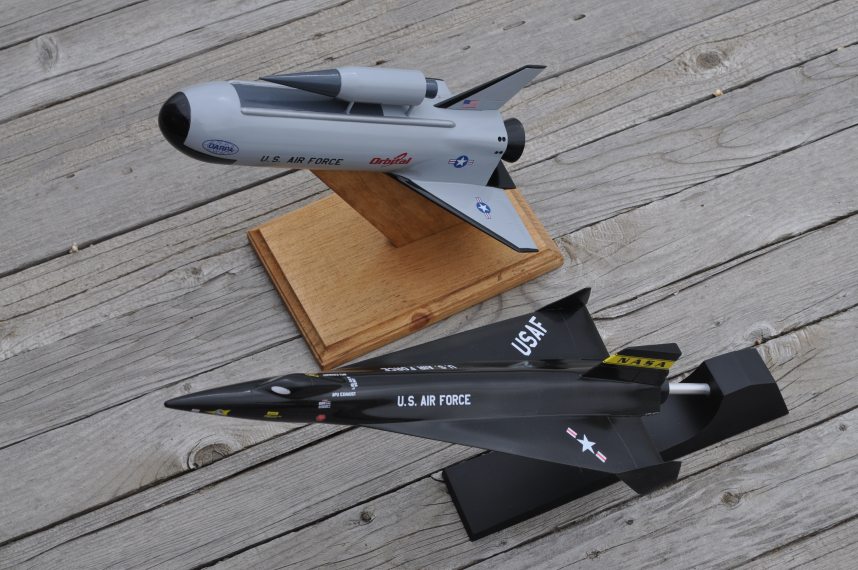
A new ground attack plane is actually being built in the US:
Seems like a reasonable design for a subsonic bushfighter, though the decision to have the engines in nacelles *that* close to the wings, but not faired into them, seems odd. That area looks draggy. At first glance it would seem that fairing that spot over wouldn’t increase drag but would decrease weight.
It has six underwing hardpoints and an internal payload bay. first flight is by the end of the year, pretty quick by normal aerospace standards (development began in early 2012). With the DoD buy a combat aircraft that was not developed to their specifications?
| Aircraft Length | 43 ft 6 in |
| Wingspan | 47 ft 4 in |
| Height | 14 ft 0 in |
| Standard Empty Weight | 11,800 lbs |
| Max Takeoff Weight | 21,250 lbs |
| Max Internal Fuel Load | 6,000 lbs |
| Max Internal Payload Bay | 3,000 lbs |
| Thrust | ~8,000 lbs |
| Max Speed | 450 KTAS |
| Service Ceiling | 45,000 ft |
| Ferry Range | 2,400 NM |
